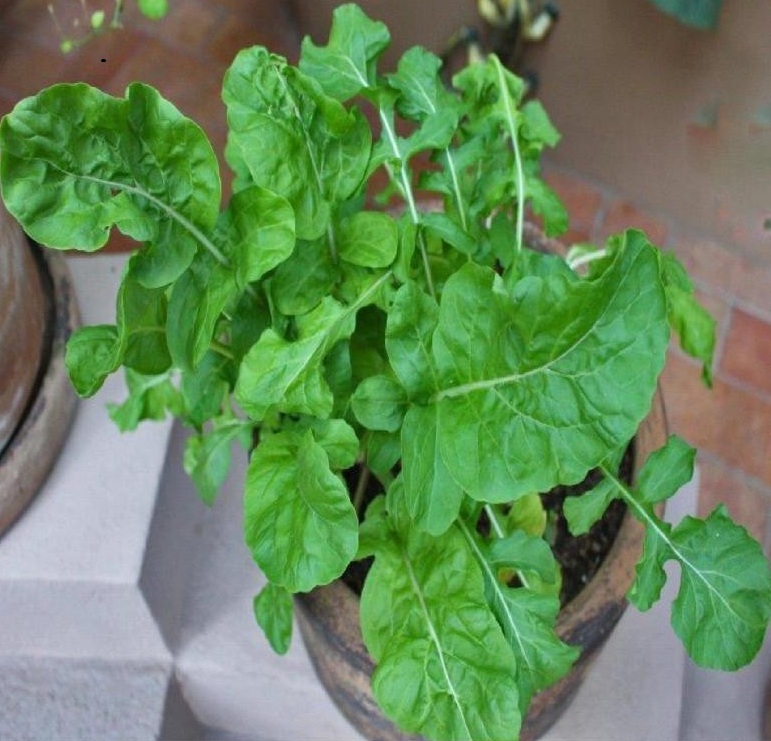By Tommy Clarkson from the March 2015 Edition
(Eruca sativa)
Family: Brassicaceae
Also known as: Salad Rocket, Rucola, Rucoli, Tugula, Colewort or Roquette
Arugula is a salad green with plenty of pizazz and probably, more for those with an adventuresome palate! Long been popular in France and Italy, it, increasingly, these days, it can be found in larger grocery stores labelled as ‘Baby Arugula.’
Should you find that you like it and want to grow your own, it will do so in a rosette of deeply lobed leaves equally a foot wide and tall. We have one on display and it inevitably delights visitors to Ola Brisa Gardens who taste it for the first time while on tour here.
When cooked or consumed like spinach, it is considered a vegetable. However, it also can be used more sparingly as an herb in the flavoring of a salad, meat, or pasta sauce. But take note – it is not for those who seek the more mild flavor like that of Iceberg Lettuce.
There are various delightful recipes for Arugula leaves in salads easily found online or one can add its flowers when the plants grow a tall bloom. A person can also sauté or steam the leaves as one might spinach or other leafy greens. However, at the point that it has the flowers, the leaves may become more pungent than may suit some folks taste. ButI’d encourage that you try them nonetheless.

And for those watching their calorie/fat intake, one-half cup (10 grams) has three calories, 0 amount of saturated fat, 0 polyunsaturated fat, 0 monounsaturated fat and 0 amount of cholesterol!
Arugula grows fast. Those set in a sunny garden location in early spring are ready for harvest toward spring’s end and, in turn, those planted late in the summer are ready by fall harvest. It’s a bit important to note that they actually prefer the cooler days of spring or fall – I can relate to that!
Just as other leafy greens, Arugula prefers a rich, compost-like soil to achieve its best growth. If you can find such, I’d suggest that you apply a timed-release fertilizer at its label-directed rate for lettuce or other leafy greens. Keep the soil evenly moist. When growing several plants, space the plants 12 to 18 inches (30.5 to 46 cm) apart.
One should pick only the outer leaves. This allows the plant to remain intact and usable for weeks to come. This process of “cut-and-come again” harvesting will keep your Arugula yielding lots of leaves until it decides to flower. Remember to harvest often so as to encourage new growth.
Similar to leaf lettuce, mustard and collards, during hot weather, Arugula reaches toward the sky, soon blooming and setting seeds. Some folks pull the plant up when it starts to show its center-based bloom stalk – 24-36 inches (61 – 91.5 cm) tall. However, other gardeners cut the plants back to get yet one more harvest as it grows back.

After the flowering, the next step is up to you. Some cover the stems with paper bags or old nylon stockings in order to catch the seeds as the pods open. Whereas others simply clip the stems and take the pods to a more secure, wind free area until they’re ready to harvest perhaps hanging them upside down in a paper bag for a week or so. It’s easy to know when this is as one can hear a rattling sound the pods are shaken.
Next, it’s threshing time. If the seeds are already in a bag, simply shake the bag or stick your hand in the bag and crumble the dried pods. Ultimately, you will have a pile of quite small, dark seeds mixed in with papery pod chaff. To separate this out, simply put everything in a shallow pan and blow the chaff off as the seeds weigh more than the chaff and will stay put. A more neat, clean (if not prissy) way is to place it all in a sieve with holes bigger than the seeds, but smaller than the chaff and then, proceed to shake!
Once the seeds are separated, you can store them in a zip-lock bag in the refrigerator. I would encourage you to label then with the date and year. I know of other folks who store them in old pill bottles, envelopes or jars. (My favorite is the small. clear plastic with a white plastic top, rectangular Tic-Tac container.) Then, make sure you store them in a cool, dry environment.

For back issues of “Roots”, gardening tips, tropical plant book reviews and videos of numerous, highly unique eco/ adventure/ nature tours, as well as memorable “Ultimate Experiences” such a Tropical Garden Brunches. Visit us at.. www.olabrisagardens.com
Download the full edition or view it online
—
Tommy Clarkson is a bit of a renaissance man. He’s lived and worked in locales as disparate as the 1.2 square mile island of Kwajalein to war-torn Iraq, from aboard he and Patty’s boat berthed out of Sea Bright, NJ to Thailand, Germany, Hawaii and Viet Nam; He’s taught classes and courses on creative writing and mass communications from the elementary grades to graduate level; He’s spoken to a wide array of meetings, conferences and assemblages on topics as varied as Buddhism, strategic marketing and tropical plants; In the latter category he and Patty’s recently book, “The Civilized Jungle” – written for the lay gardener – has been heralded as “the best tropical plant book in the last ten years”; And, according to Trip Advisor, their spectacular tropical creation – Ola Brisa Gardens – is the “Number One Tour destination in Manzanillo”.





You must be logged in to post a comment.